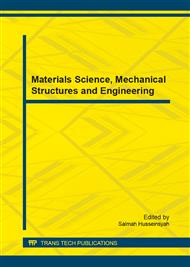p.77
p.81
p.85
p.89
p.93
p.97
p.102
p.106
p.111
Contact Angle Analysis on Glass Based Surface
Abstract:
This paper reports on the contact angle measurement analysis on a glass based surface for anodic bonding process cleaned by three distinct cleaning processes. The three types of glass based surface used were silica, pyrex, and soda lime glass. The three cleaning solutions tested in this experiment were RCA, piranha and acetone. Water Droplet Test (WDT) was done to analyze the contact angle of micro droplet on sample surface. It can be done by dropping a droplet of water in constant volume at the fixed height and angle. Only RCA process constantly decreases the contact angle value after cleaning. The compilations of data strongly proved that all samples become hydrophilic after RCA cleaning process. The solid surface is considered hydrophilic when water contact angle is smaller than 90°, and hydrophobic profile if the water contact angle is larger than 90°. Samples which undergo piranha and acetone cleaning did not prove any characteristic of hydrophilic or hydrophobic surface after cleaning.
Info:
Periodical:
Pages:
93-96
Citation:
Online since:
October 2014
Keywords:
Price:
Сopyright:
© 2014 Trans Tech Publications Ltd. All Rights Reserved
Share:
Citation:


